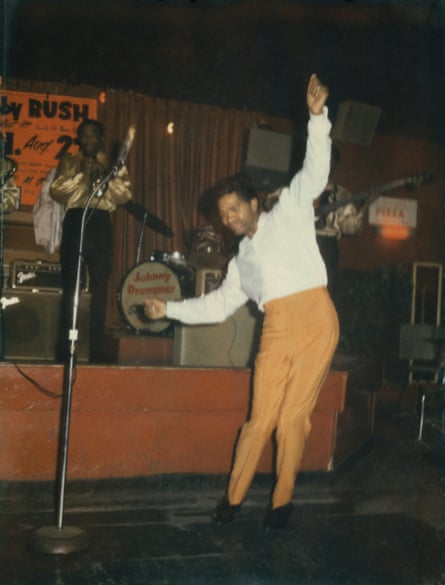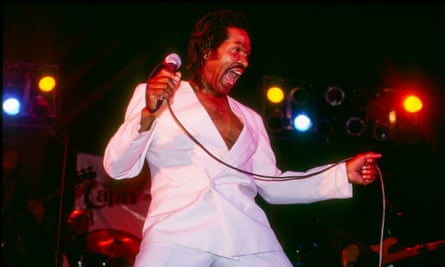The King of the Chitlin’ Circuit. The Hardest Working Man in Showbiz. The Funkiest Man Alive. These are just three honorary titles bestowed on Bobby Rush, and he wears them all with joyous pride. Rush had planned to start the new year with two performances in London until Omicron cancelled his entire European tour, but relaxing at home in Jackson, Mississippi, the 88-year old exudes bonhomie. Covid-19 has already disrupted his life plenty, forcing a man who, until 2020, spent the past five decades working over 200 nights a year, to take time out. Did he relax? Rush laughs: “Sure I did. I got busy in my home studio cutting new material.”
This was after he recovered from coronavirus. “I was the first person in Mississippi to get Covid,” says Rush. “It was before they had the vaccines and I got real ill, hospitalised for five weeks. I survived through God’s grace and the fact that I’ve always kept fit, never touched drugs or alcohol. But it sure beat up on me like nothing else before.”
Rush’s 2021 autobiography I Aint Studdin’ Ya details this and many other scrapes in an epic American life. Considering he started performing aged 13 and released his first record in 1964, what’s most remarkable is a work ethic that has seen him win wider acclaim and audiences in recent years – picking up Grammys in 2017 and 2020, appearing in the Eddie Murphy movie Dolemite Is My Name and joining Queens of the Stone Age on stage – than ever before. Unlike John Lee Hooker and Johnny Cash, who were both successfully repositioned in their twilight years, Rush never enjoyed early fame. Instead, his growing audience is due purely to his skill as an entertainer. “People love my show cos I emphasise good times,” he says. “I encourage people to wear a smile, not a frown.”
Rush describes his show (or “revue”) as “Black vaudeville” – song, dance, storytelling, often bawdy humour – and these elements provided the key to his breakthrough: The Road to Memphis, the 2003 documentary that was easily the strongest effort in Martin Scorsese’s The Blues series, and followed Rush as he worked, his personality and performances winning over new listeners. Add to this a new manager with a vision of how to take Rush forward and he entered his 80s doing better business than ever.

“I didn’t want anyone to read the book and feel sorry for me,” says Rush of a life that has seen him get shot, jailed, badly injured when his tour bus crashed and, most punishingly, lose three of his children to sickle cell anaemia. Musicians helped him on the hard road to success but James Brown, both when Rush was a junior and later a veteran, left him out of pocket when he offered largesse. “Some men behave like dogs,” says Rush. “My thing has always been to not give up, to keep on pushing – as Curtis Mayfield sang. All those hills and valleys I’ve climbed, well, someone always came through and lifted me out. Life is so short that I take the good as the overlap of the bad.”
Born Emmet Ellis Jr in Homer, Louisiana, to sharecropping parents, segregation overshadowed a dirt poor upbringing. “We didn’t have no electricity in our home,” says Rush. “Only an outside toilet. Grew up picking cotton and got little schooling. But Daddy and Momma loved us and raised us right and, even if they had very little money, made sure we got the essentials. It’s Black folks’ oldest blues song in America – making a way out of no way.”
Emmet Jr decided to make his own way aged 13, leaving home to work full time as a farm labourer. Determined to perform, and being tall and confident, he began sitting in with blues musicians playing local juke joints (shanty bars often built on plantations). Aged 15, he joined the Rabbit’s Foot Minstrels troupe as a singer and dancer, dabbing burnt cork on his face (as was then expected of minstrels) before performing.
“Bessie Smith and Louis Jordan and many others started out with minstrels,” he states. “Minstrels also created Black vaudeville, and Sammy Davis Jr and others came out of that. I’m not defending minstrels, I’m just saying it was a bridge for a lot of us to enter the entertainment industry.”
He changed his name to Bobby Rush – out of respect for his father, who was now a preacher and blues was considered the devil’s music – and worked juke joints where sharecroppers would drink and dance. Shifting to Memphis, Rush was befriended and schooled in the basics of the music industry by Rufus Thomas and Albert King, then, in 1953, joined the great migration of African Americans northwards. In Chicago, he built himself a reputation as an entertaining performer but little else – he worked a hotdog stand, opened a barbecue outlet, collected scrap metal, grafting hard to support his family. Releasing seven 45s on six different independent record labels between 1964 and 1971, he finally clicked when Chicken Heads reached No 34 on the US R&B charts. “Folk funk” is how Rush described his sound and his hit became a staple on southern jukeboxes, selling a million copies. A bad deal meant he saw no royalties but it brought him more bookings and audiences loved him. “We in the entertainment business,” he says, “so I strive to do that: entertain.”
Philadelphia International Records signed Rush and, in 1979, released his debut album Rush Hour, but it won scant attention. Aged 46, he refused to quit and kept working the clubs. An underground star, Rush soon became known as “the King of the Chitlin’ Circuit” and to many Black Americans, that is royalty indeed.

“The chitlin’ circuit ain’t nothin’ but a place where we Negroes could go and have a good time,” he says of a loose network of African American clubs that provided loyal audiences for the likes of Denise LaSalle, Latimore, ZZ Hill, Shirley Brown and other noted soul/blues artists who never managed to crossover to white audiences as Al Green, Buddy Guy and Aretha Franklin did. Chitlings are fried pigs’ intestines: slaves were often given them by slavemasters after a pig had been slaughtered and developed this into a staple of “soul food”. Rush notes that they cleaned up the shit-filled pig’s colon and seasoned it into a delicacy, “just as we would take run-down old theatres and turn them into an oasis for Black people to escape all the shit we were taking from the outside world”. While the chitlin’ circuit extends across the US, its stronghold is in the south and, in 1983, Rush relocated from Chicago to Jackson, Mississippi, to work it.
Rush’s folk funk ensures his songs are laden with country homilies, broad wit and lusty innuendos: She Caught Me With My Pants Down, Santa Claus Wants Some Too and What’s Good For the Goose Is Good for the Gander are funky and lascivious. One number, Big Fat Woman, became a comedy trope in Rush’s show and he has long employed “shake” dancers – amply proportioned Black women who shake their rears while he sings. The shake dancers go down a storm on the chitlin’ circuit but are less welcome in Europe: he was booed at a Dutch festival, while his 2005 performance at London’s Barbican Hall had this paper’s reviewer damning Rush as “simply pathetic”.
A year before his Barbican debut, where the predominantly white audience exuded silent discomfort, I had seen Rush perform in Mississippi to an almost entirely Black audience who whooped, dirty danced and sang along. It’s a cultural conundrum: there’s nothing nasty in his celebratory shows but, inevitably, humour doesn’t always travel well. I mention European criticism of his dancers and Rush’s reply contains tempered fury. “Shake dancers are from Africa,” he states. “It’s what Black people do. Booty is part of our Blackness and I’m not ashamed of who I am or where I come from.”

Twerking, I suggest, comes from shake dancers. “You got it,” he replies. “Rappers love what I do cos I’m swift with the lyrics.”
This noted, Rush has toned down his act: his 2019 performance at London’s Jazz Cafe found him accompanied by one somewhat restrained shake dancer. He’s also remodelled his sound: glossy keyboards and soul stylings have given way to an elemental blues with Rush playing magnificent harmonica. Indeed, his 2022 shows were going to be his first entirely solo concerts in Europe.
“In 1970, Rufus Thomas advised me to retire the harmonica because Stax had told him it sounded old-timey,” notes Rush. “More recently I noticed that there was a return to blues roots and so I went that way. Less vaudeville, more authenticity. I wanted to show people where I came from … the sound I started out with.”
In The Road to Memphis, Rush mentioned how, while he commanded a huge Black audience, he hoped he could cross over to a white one. Now that he has achieved this, I wonder if he still plays the chitlin’ circuit.
“I crossed over but I didn’t cross out – you get me?” he replies. “Some Black artists – and I’m not naming names – cross over and lose their people. Not me. I can still play a club in the Black part of Memphis and pull thousands of people. Then I go play on Beale Street (the city’s blues tourist strip) and get a white audience.”
In his autobiography, Rush notes how he has always possessed more energy than anyone else and, across our Zoom chat, he not only speaks with great ebullience but sings, plays harmonica and strums his guitar – everything but call on a shake dancer. His enthusiasm is infectious, this funky, funny pensioner who exudes Black pride and joy.
“A lot of things have changed across my life,” says Rush when I ask about Black Lives Matter, “but still plenty remains the same. Music has a link to freedom; it’s a great place to bring people together, build friendships and understanding. That’s why I’m still going out there.”
I Aint Studdin’ Ya is published by Hachette.
